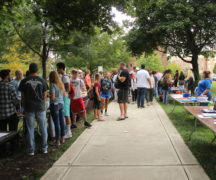By DAVID DUPONT
BG Independent News
Bowling Green State University’s Division of Student Affairs has earned recognition coast to coast.
A couple weeks ago Thomas Gibson, vice president for student affairs and vice provost, was in Boston receiving a national award from NASPA, Student Affairs Administrators in Higher Education.
“BGSU was selected as a one of 2019’s most promising places to work in student affairs,” Gibson said.
This week Gibson is in Los Angeles to receive aa gold award for its Falcon Success and Retention Curriculum.
That program, FSRC, has already earned praise right here in Bowling Green for keeping more students at BGSU after they’ve enrolled. That’s key for students. It’s also important for BGSU’s finances since how much money it gets from the state depends on how many students it retains and eventually graduates.
Gibson traced the effort back to 2014, two years before he came to campus. Before that time, he said, resident assistants were “heavily focused” on social and engagement programs . These were activities to encourage students get out of their rooms and meet each other. They were light-hearted — game nights, trivia games, and the like. These were intended to build community.
But the university was having a problem retaining students.
University administrators understood they needed a new model, Gibson said. This involved combining the social engagement with “individual, intentional conversations with residents.”
Resident assistants would make a point of speaking to students one on one about the challenges they were facing as well as the successes they had.
These “date-rich” conversations yielded a lot of information about students who may be having problems, students who may be considering not returning for the next semester, as well as students who are having a great experience.
Those conversations, Gibson explained, were framed by questions developed by student affairs professionals. They center on five areas:
- Safety
- Student engagement, how involved they were in campus activities whether clubs, Greek life, research or community service
- Inclusivity, how much they felt at home at BGSU;
- Personal growth
- Academic success.
These are all central to keeping students at BGSU. Studies show, Gibson said, that those students who are engaged in campus activities are more likely to stay. BGSU also needs to know whether students feel the university is a good personal fit for them, and, if not, how to make it so.
“We want to make sure we’re being inclusive in our approach and that everyone can find a home at BGSU,” he said.
“We began to understand how students were experiencing the institution as a result of having so much data.”
Overall, just over 90 percent of first year students who enroll in fall, return for the spring semester. This is the persistence rate.
The university is aiming for a retention rate — the number of students who return for their sophomore year — of 80 percent. Last fall, the university reported it retained 77 percent of students who entered the previous year.
These efforts dig into why students may leave.
“Once students share with us that they are experiencing some challenges, they are now part of our priority list. … We have greater touch points with these students. We pay attention to them. We follow up with them.”
That could be someone to help them get socially engaged. It could mean working more closely with their academic advisor or faculty. It could mean seeking tutoring help.
“Now the student has someone to help motivate them and connect them to campus or community resources as well as holding them accountable for achieving success in the classroom,” Gibson said.
“We may find that some students are struggling financially,” he added, “and that may be the only reason they are considering not returning for the subsequent semester. In that case we begin to assess our institutional resources to determine how we may be able to retain that student.”
While these efforts were initially directed at the 6,000 students, mostly first and second year students, who live in residence halls, student affairs has also increased its outreach to commuters.
“Research suggests and, certainly I see it here, that students who reside on campus persist and retain at higher rates than students who do not,” Gibson said. “Students who are immersed in the life of the university have more reminders that you’re at a university where your job is to study and do well in your classes and fully participate in the campus experience.
“Off campus you don’t have those constant reminders,” he said. “Those students have to work a little harder to stay connected.”
Gibson distinguished between students who no longer are required to live on campus, and choose to seek housing nearby to campus, and those who live with family within a 50-mile radius of campus. Those students may be traditional students still living with their parents, or they may be post-traditional students with children of their own.
Those students who have opted out of the residence halls after two years “have typically gotten the hang of what’s required of them academically,” Gibson said. They tend to do better than students who simply come to campus to take classes and leave.
Trustee Betty Montgomery has spoken at meetings about how she as a commuting student sometimes did not feel as much part of campus life.
Gibson said BGSU is trying to bring commuting students together more, giving them a chance to meet their commuting peers.
Those initial efforts have shown signs of success with retention for that cohort up 4 percent from last year.
Now, he said, student affairs officials would like to take the award-winning curriculum and test if it can be applied to commuters.
“If so, what would those interactions and conversations sound like? We should be leveraging this curriculum with commuters,” he said.
“It’s about developing a community of care for students.”
And if they succeed, Gibson and others will be hitting the road to share that curriculum with other colleges.



